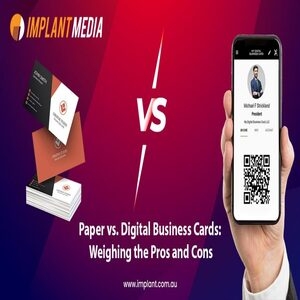Printed vs. Virtual Business Cards: Evaluating the Benefits and DrawbacksPosted by implant media on November 7th, 2023  In today's digital age, the traditional exchange of printed business cards is facing increasing competition from their virtual counterparts. As professionals and entrepreneurs adapt to the evolving landscape of networking and communication, it's essential to weigh the pros and cons of printed and virtual business cards to determine which method is more effective in achieving your networking goals. In this blog post, we will explore the benefits and drawbacks of both printed and virtual business cards, allowing you to make an informed decision that suits your specific needs. Printed Business CardsBenefits1. Tangibility and Personal ConnectionPrinted business cards offer a tactile experience that virtual cards cannot replicate. When you hand someone a physical card, it creates a personal connection that can leave a lasting impression. The feel of the card, its design, and its visual appeal can all contribute to a memorable encounter. 2. Offline AvailabilityPrinted cards don't require an internet connection, making them readily accessible in various situations. You can distribute them at networking events, conferences, and even during chance encounters with potential clients or partners, regardless of the availability of Wi-Fi or mobile data. 3. Unique DesignsWith printed cards, you have creative freedom to design a unique and eye-catching card that reflects your brand's personality. You can experiment with different paper textures, finishes, and design elements to make your card stand out in a stack. Drawbacks1. Limited InformationPrinted business cards have limited space, which can make it challenging to convey all the information you want to share. You may need to prioritize what details to include, potentially leaving out crucial information. 2. Environmental ConcernsThe production of printed business cards can be resource-intensive, and the disposal of unwanted or outdated cards contributes to environmental concerns. If sustainability is a priority for your brand, this is an important drawback to consider. 3. InflexibilityOnce printed, it's challenging to update or change the information on your card without incurring additional costs. This lack of flexibility can be a significant drawback in a dynamic business environment. Virtual Business CardsBenefits1. Easy SharingVirtual business cards can be easily shared through email, messaging apps, or social media. They are instantly accessible to recipients, eliminating the need to carry physical cards and reducing the risk of misplacement. 2. Multimedia CapabilitiesDigital cards allow you to include multimedia elements like videos, links to your website or portfolio, and interactive content. This dynamic presentation can help you provide a comprehensive overview of your skills and offerings. 3. Eco-FriendlyVirtual business cards have a minimal environmental impact as they eliminate the need for paper production and reduce waste. For eco-conscious professionals, this is a significant advantage. Drawbacks1. Dependence on TechnologyUsing virtual business cards requires a smartphone, tablet, or computer with internet access. If you encounter someone without these tools, you may miss an opportunity to connect. 2. Impersonal InteractionThe act of exchanging virtual business cards lacks the personal touch of handing someone a physical card. It may not leave the same impression as a face-to-face exchange. 3. Privacy ConcernsSharing digital business cards may require the exchange of contact information, which some individuals might be hesitant to provide due to privacy concerns. This can limit the effectiveness of virtual cards in certain situations. Choosing the Right Option for YouThe decision between printed and virtual business cards ultimately depends on your specific needs, preferences, and circumstances. Here are some factors to consider when making your choice: 1. Your Target AudienceConsider the preferences of your target audience. Are they more likely to appreciate the tactile nature of printed cards, or are they tech-savvy individuals who prefer digital interactions? 2. Networking EnvironmentThink about the networking environments you frequent. If you often attend conferences and events with limited internet access, printed cards might be more practical. However, in tech-savvy, urban settings, virtual cards could be more efficient. 3. Sustainability GoalsIf environmental sustainability is a core value of your brand, digital business cards align better with eco-friendly practices. Content ComplexityConsider the complexity of the information you want to share. If you need to provide multimedia content, links, and frequent updates, virtual business cards offer more flexibility. Cost ConsiderationsFactor in the cost of designing and printing physical cards versus creating and maintaining digital versions. Depending on your budget, one option may be more cost-effective. ConclusionThe debate between printed and virtual business cards doesn't have a one-size-fits-all answer. Both have their distinct advantages and drawbacks, and the right choice depends on your unique circumstances and objectives. As you evaluate the options, keep in mind the importance of adaptability in the evolving world of networking. Combining both printed and virtual business cards may be the ideal solution, allowing you to leverage the strengths of each format based on the situation. Ultimately, the effectiveness of your business cards, whether printed or virtual, hinges on the quality of the content they convey and your ability to make a lasting impression during networking encounters. As technology continues to shape the way we connect and communicate, staying open to innovative approaches while respecting traditional practices can be a winning strategy in the world of business networking. Like it? Share it!More by this author |


